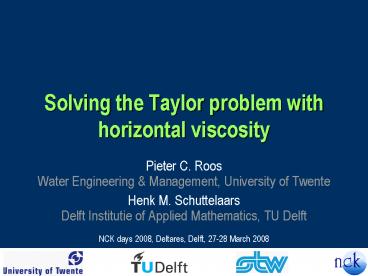Solving the Taylor problem with horizontal viscosity PowerPoint PPT Presentation
1 / 21
Title: Solving the Taylor problem with horizontal viscosity
1
Solving the Taylor problem with horizontal
viscosity
- Pieter C. Roos Water Engineering Management,
University of Twente - Henk M. SchuttelaarsDelft Institutie of Applied
Mathematics, TU Delft - NCK days 2008, Deltares, Delft, 27-28 March 2008
2
Contents
- Motivation and goal
- Background inviscid Taylor problem
- Viscous Taylor problem
- Results
- Open channel modes
- Viscous Taylor solution
- Conclusions
- Outlook
3
1. Motivation and goal
- Understand morphodynamics of tidal basins
- Tool process-based model for tidal flow
- Smooth flow field required ? add horizontal
viscosity - Arbitrary box-type geometries ? Taylor problem
4
2. Background inviscid Taylor problem
- Semi-infinite rectangular basin of uniform depth
- No-normal flow BC
- Inviscid shallow water eqs.
- Incoming Kelvin wave
Co-tidal and co-range chart
Tidal current ellipses
Source Taylor (1921)
5
2. Background inviscid Taylor problem
- Semi-infinite rectangular basin of uniform depth
- Solution as superposition of open channel modes
- Kelvin Poincaré waves
- Collocation method
- Amphidromic system and tidal current ellipses
Co-tidal and co-range chart
Tidal current ellipses
Source Taylor (1921)
6
2. Extending inviscid Taylor problem
- Semi-infinite rectangular basin of uniform depth
- Solution as superposition of open channel modes
- Extension to arbitrary box-type geometries
- Problems for flow field at reflex angle-corners
- Remedy add viscosity
?(x,y,t)
Tidal current ellipses
7
3. Viscous Taylor problem
- Geometry and boundary conditions
- Free surface elevation ?, depth-averaged flow
(u,v) - No slip at closed boundaries (u,v)0
- Incoming Kelvin wave from x8
y?
Kelvin wave
B
Uniform depth H
x?
x0
8
3. Viscous Taylor problem
- Geometry and boundary conditions
- Linearized shallow water equations at O(Fr0)
- g?x ut fv ?uxxuyy
- g?y vt fu ?vxxvyy
- ?t Hux Hvy 0
- Acceleration of gravity g, Coriolis parameter f,
water depth H, horizontal viscosity ?
9
3. Viscous Taylor problem
- Geometry and boundary conditions
- Linearized shallow water equations at O(Fr0)
- Solution method
- Find viscous open channel modes
- Write solution as a superposition of these modes
- Use collocation method to satisfy no slip BC at
x0
10
4. Results open channel modes
- General form ?(x,y,t) Z(y)exp(i?t-kx) c.c.
- Angular frequency ?, (complex) wave number k
- Transverse structure Z(y) Z1e-ay Z2e-ßy
Z3eay-B Z4eßy-B - Solvability condition from BCs at y0,B ? k, a,
ß, Zj
y?
B
Uniform depth H
x?
x0
11
4. Open channel modes
inviscid
12
4. Open channel modes
inviscid
viscous
13
4. Open channel modes
viscous
- Viscous Kelvin and Poincaré modes
- Boundary layers at y0,B
- Interior structure similar to inviscid case
- Viscous dissipation, slight decrease in length
scales
y?
B
Uniform depth H
x?
x0
14
4. Viscous Kelvin mode
viscous
15
4. Viscous Poincaré modes
viscous
16
4. Viscous Poincaré modes
viscous
17
4. New modes
viscous
18
4. Viscous Taylor solution
- Truncated superposition of open channel modes
- Incoming Kelvin wave and 2N1 reflected modes
- Use collocation method to satisfy no-slip BC at
x0 - N1 points where u0 and N points where v0
y?
Kelvin wave
x?
x0
19
4. Viscous Taylor solution
viscous
20
5. Conclusions
- Taylor problem has been extended to account for
horizontally viscous effects - No-slip condition at closed boundaries
- Solution involves viscous open channel modes
- Viscous Kelvin and Poincaré modes
- A new type of mode arises, responsible for the
transverse boundary layer at x0
21
6. Outlook
- Details of collocation method
- Residual flow and higher harmonics
- Nonlinear M2-interactions at O(Fr1) ? M0, M4
- Geometrical extension of viscous model
- To arbitrary box-type geometries ? smooth flow
field - Applications artificial islands, inlets,
obstructions

